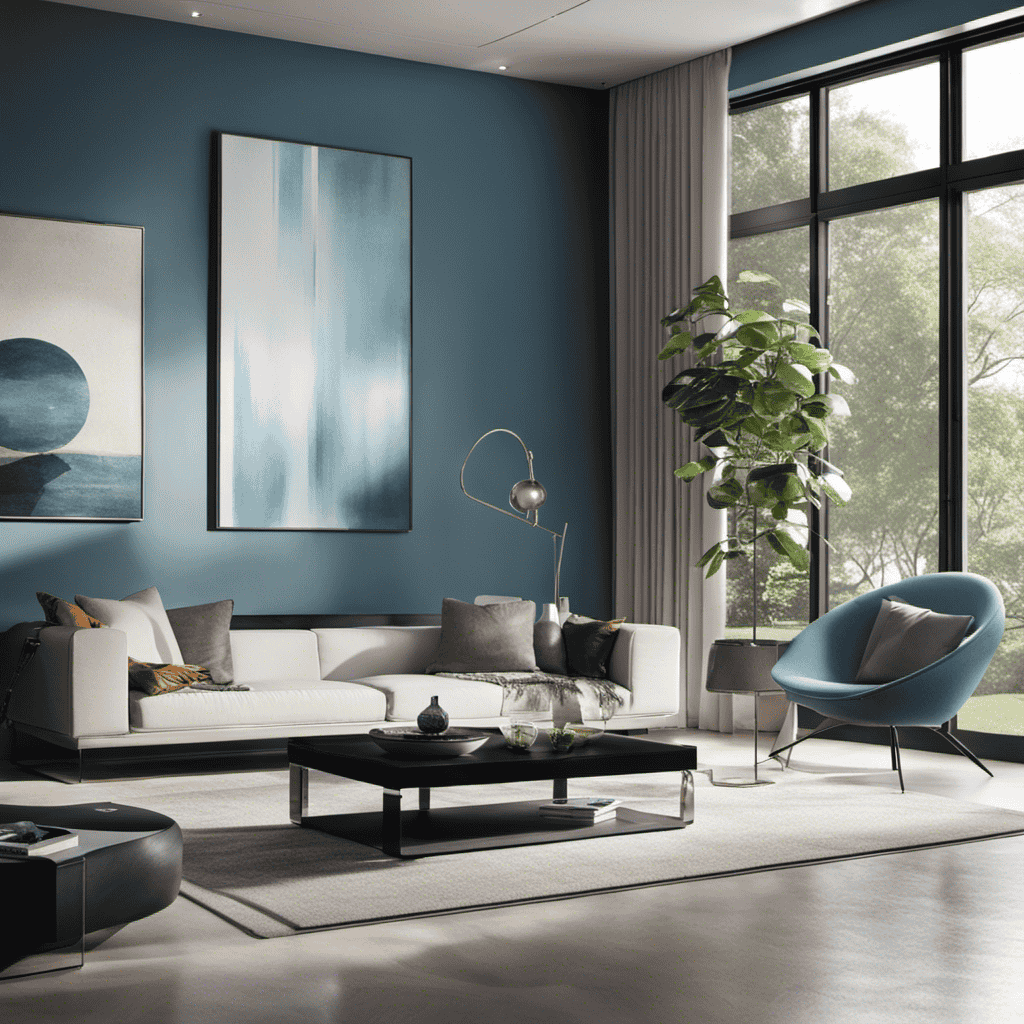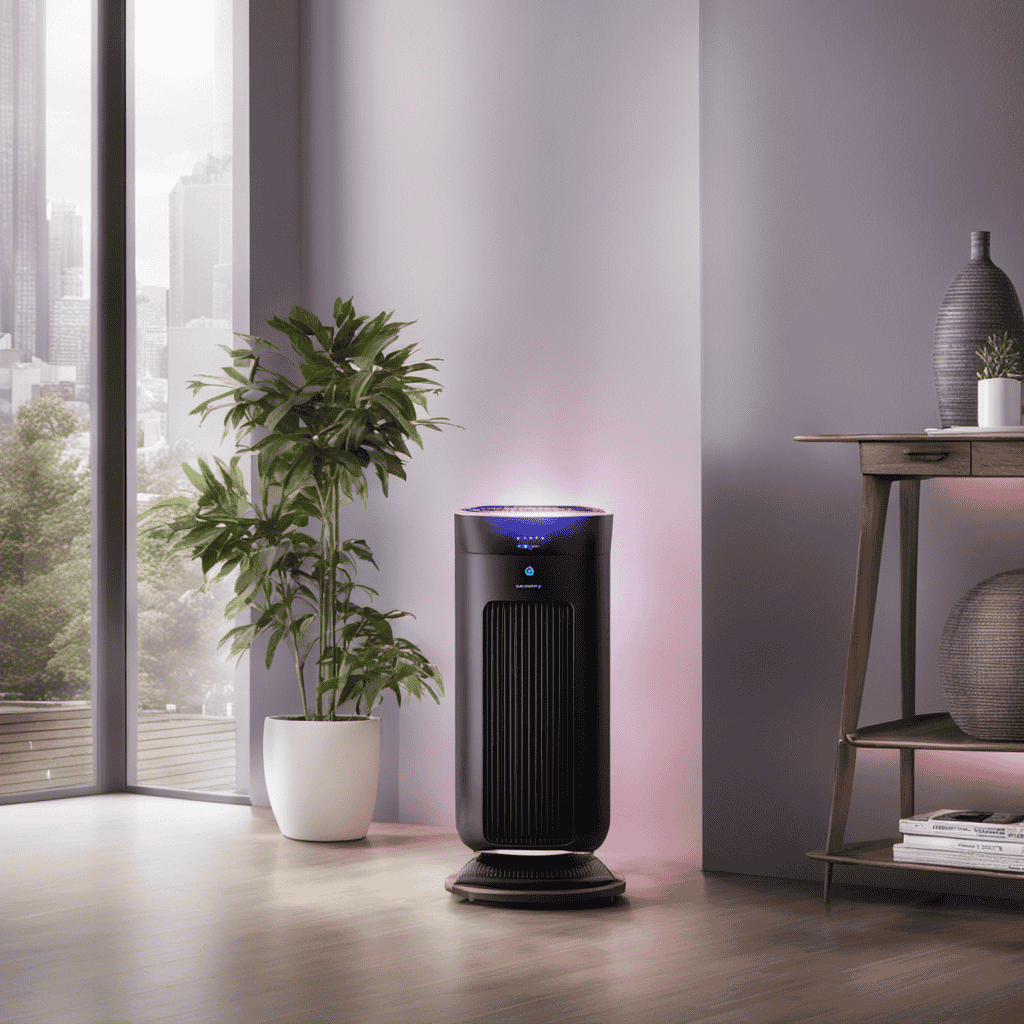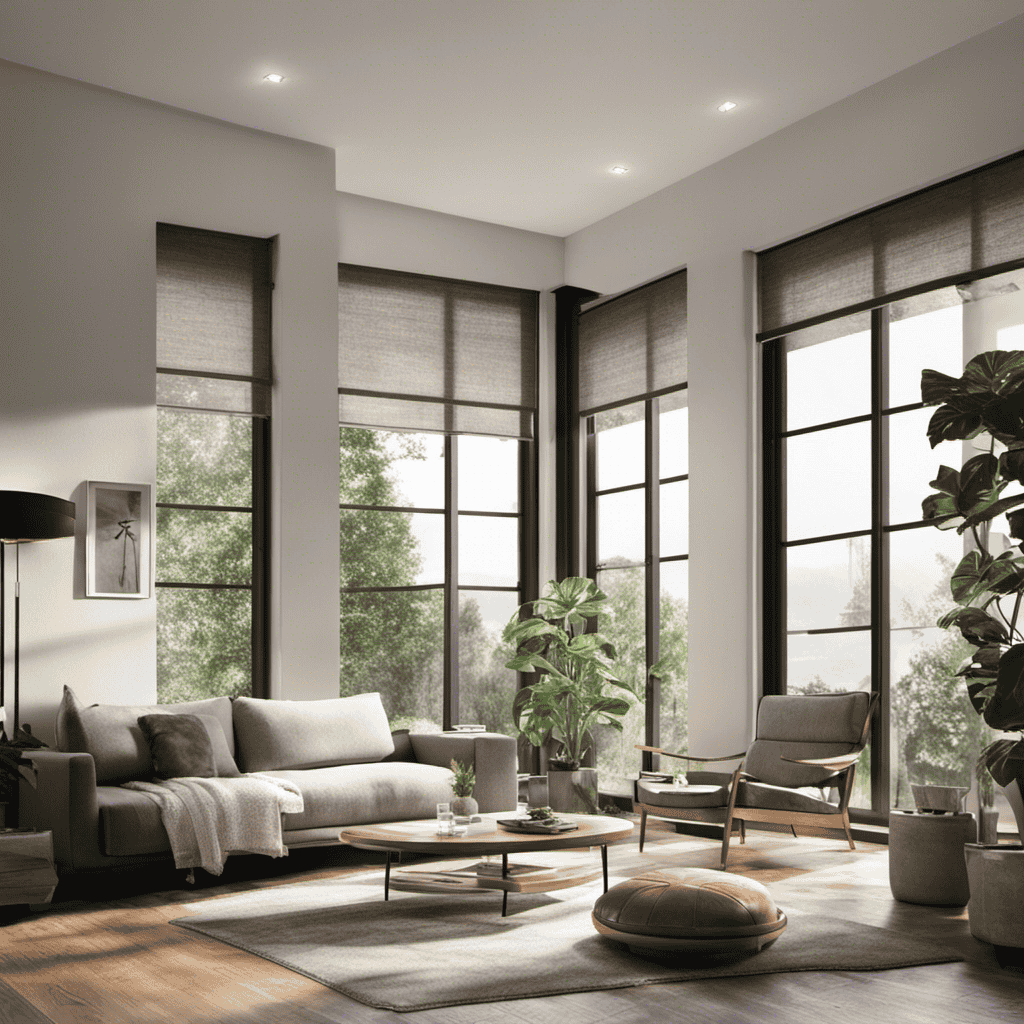Common Air Purifier Problems and How to Fix Them
I’ve got to tell you, air purifiers can be a lifesaver when it comes to improving indoor air quality. But let me be real with you – they’re not perfect. Sometimes, these machines can run into some pesky problems that can leave you scratching your head.
That’s why I’ve put together this article, where I’ll guide you through the most common air purifier issues and show you how to fix them. Trust me, you’ll be breathing fresh, clean air in no time!
Key Takeaways
- Regularly replace the air purifier filter to maintain efficiency and prevent reduced airflow and strange odors.
- Adjust fan speed settings to increase airflow and improve overall performance.
- Remove and clean clogged filters regularly according to manufacturer’s instructions.
- Choose a suitable location for optimal effectiveness, keeping the surrounding area clean and free from obstructions.
Filter Issues
If you’re experiencing reduced airflow or strange odors, it’s likely that your air purifier’s filter needs to be replaced. Dirty filters can hinder the performance of your air purifier and reduce its ability to effectively clean the air in your home. Regularly replacing your air purifier’s filter is essential to maintain its efficiency and ensure the highest quality of air in your living space.
When it comes to replacement filters, it’s important to choose the right one for your specific air purifier model. Different air purifiers require different types of filters, so be sure to check your manufacturer’s recommendations. Replacement filters are typically available for purchase from the manufacturer or authorized retailers.
To replace the filter, start by turning off and unplugging your air purifier. Locate the filter compartment, which is usually at the back or bottom of the unit. Open the compartment and carefully remove the old, dirty filter. Dispose of it properly.
Take the new replacement filter and insert it into the filter compartment, making sure it is properly aligned. Close the compartment securely and plug in your air purifier. Turn it on and enjoy the improved airflow and fresh, clean air in your home.
Regularly checking and replacing dirty filters is crucial for maintaining the effectiveness of your air purifier. By following these simple steps, you can ensure that your air purifier continues to provide you with clean and healthy air for years to come.
Low Airflow
When it comes to low airflow in air purifiers, there are several key factors to consider:
-
Clogged filters can significantly reduce airflow by blocking the passage of air through the unit.
-
Adjusting the fan speed settings to a higher setting can help increase the airflow and improve the overall performance of the air purifier.
-
Additionally, proper placement of the air purifier in a room can ensure optimal airflow and maximize its effectiveness in removing pollutants from the air.
Clogged Filters
To fix clogged filters, you’ll need to remove and clean them regularly. Cleaning techniques and maintenance tips are essential to ensure proper functioning of your air purifier.
Firstly, check the manufacturer’s instructions for specific cleaning guidelines. Most filters can be cleaned by gently vacuuming or rinsing them with water. Be sure to let the filters dry completely before reinserting them into the purifier.
For stubborn dirt or debris, you may need to use a soft brush or mild soap solution. Regularly inspect the filters for signs of wear and tear, and replace them if necessary.
Additionally, it’s important to clean the surrounding area of the purifier to prevent dust buildup.
Fan Speed Settings
Adjusting the fan speed settings on your air purifier is simple and can help improve the air circulation in your space. By controlling the speed of the fan, you can ensure that the air is properly filtered and circulated, reducing the presence of allergens and pollutants. Here are three reasons why adjusting the fan speed settings is important:
-
Enhanced Cleaning Efficiency: Increasing the fan speed can boost the air purifier’s cleaning power, allowing it to capture more particles and pollutants from the air.
-
Noise Reduction: Lowering the fan speed can help reduce the noise level of your air purifier, providing a quieter and more peaceful environment.
-
Energy Savings: Adjusting the fan speed to a lower setting can help conserve energy, leading to lower electricity bills and a more eco-friendly operation.
To keep your air purifier running efficiently, it is essential to include adjusting the fan speed settings in your regular cleaning routine and maintenance schedule.
Now, let’s move on to the next important aspect of air purifier functionality: air purifier placement.
Air Purifier Placement
Make sure you choose a suitable location for your air purifier to maximize its effectiveness in cleaning the air in your space.
The size of your air purifier is an important factor to consider when deciding where to place it. Larger air purifiers are typically more effective in larger spaces, while smaller ones work well in smaller rooms.
Additionally, proper maintenance is crucial for the optimal performance of your air purifier. Regularly clean or replace the filters as recommended by the manufacturer. This will ensure that the air purifier continues to effectively remove pollutants from the air.
It’s also important to keep the surrounding area clean and free from obstructions, as this can affect the airflow and overall performance of the unit.
Strange Odors
Sometimes, you may notice strange odors coming from your air purifier. Identifying the sources of these odors is crucial in order to eliminate them and ensure that your air purifier is functioning properly.
Here are three common sources of strange odors and how to address them:
-
Mold or Mildew: If you detect a musty smell, it is likely due to mold or mildew growth inside your air purifier. To eliminate this odor, first, turn off and unplug the purifier. Then, carefully remove the filters and clean them according to the manufacturer’s instructions. Additionally, wipe down the interior of the purifier with a mild detergent solution. Allow all parts to dry completely before reassembling the unit.
-
Dirty Filters: Over time, the filters in your air purifier can become clogged with dust, pet dander, and other pollutants. This can result in unpleasant odors. To eliminate this odor, regularly clean or replace the filters as recommended by the manufacturer. This will not only improve the air quality but also prevent any unwanted smells.
-
Chemical Off-Gassing: Some air purifiers may release a chemical odor when they are new or have recently undergone maintenance. This is known as off-gassing. To eliminate this odor, it is advisable to run the purifier in a well-ventilated area for a few hours until the smell dissipates.
In conclusion, by identifying the sources of strange odors and taking appropriate measures to eliminate them, you can ensure that your air purifier functions efficiently and provides you with fresh and clean air.
Now, let’s move on to the next section about noisy operation.
Noisy Operation
If your air purifier is emitting loud noises, it may be due to a malfunctioning fan or motor. The sound reduction of an air purifier is crucial for a peaceful and comfortable environment. To address this issue, there are a few maintenance tips you can follow.
Firstly, check the fan and motor for any visible signs of damage or debris. Sometimes, the noise can be caused by a loose or misaligned fan blade. In such cases, carefully tighten or realign the blade to reduce the noise.
Additionally, regular cleaning is essential for optimal performance and noise reduction. Dust and dirt accumulation can affect the fan’s operation, leading to loud noises. Clean the exterior and interior of the air purifier, focusing on the fan and motor area. Use a soft cloth or brush to remove any dirt or dust particles.
Moreover, lubricating the fan and motor can also help reduce noise. Consult the manufacturer’s instructions to identify the appropriate lubricant and apply it to the necessary components.
Power Supply Problems
The most likely cause of noisy operation in an air purifier is a malfunctioning fan or motor. However, noisy operation can also be due to power supply problems. If your air purifier suddenly stops working or experiences intermittent power issues, it could be a result of a power outage or a faulty cord.
Here are three possible power supply problems that could be causing the issue:
-
Power Outage: A sudden loss of power can disrupt the functioning of your air purifier. Check if there has been a power outage in your area and ensure that the power supply has been restored before troubleshooting further.
-
Faulty Cord: A faulty power cord can prevent the air purifier from receiving adequate power. Inspect the cord for any visible damage or fraying. If you notice any issues, replace the cord with a new one to restore power to the unit.
-
Loose Connections: Sometimes, the power plug or the connection between the plug and the air purifier may become loose over time. Ensure that the power plug is securely inserted into the outlet and that the connection is tight. A loose connection can cause power interruptions and affect the performance of the air purifier.
Malfunctioning Controls
When it comes to troubleshooting unresponsive buttons on an air purifier, there are a few key steps to take.
First, check for any debris or dust that may be causing the button to stick or not respond properly.
Next, try resetting the control panel by turning off the air purifier, unplugging it from the power source, and waiting for at least 10 seconds before plugging it back in and turning it on again.
These troubleshooting techniques can often resolve issues with unresponsive buttons and ensure that your air purifier is functioning properly.
Unresponsive Button Troubleshooting
One common issue with air purifiers is that buttons may become unresponsive, requiring troubleshooting. When faced with an unresponsive button on your air purifier, there are a few solutions you can try before resorting to professional help. Here are three troubleshooting tips to help you fix the problem:
-
Check the power source: Ensure that your air purifier is properly connected to a functioning power outlet. Sometimes, a loose or faulty power connection can cause buttons to become unresponsive.
-
Reset the device: Many air purifiers have a reset button or option that can help resolve button responsiveness issues. Refer to your user manual to locate the reset option and follow the instructions provided.
-
Clean the buttons: Over time, dust and debris can accumulate on the surface of the buttons, leading to unresponsiveness. Gently clean the buttons using a soft cloth or cotton swab dipped in a mild cleaning solution.
Resetting Control Panel
After troubleshooting unresponsive buttons on my air purifier, I encountered another problem: a malfunctioning control panel. To address this issue, I needed to reset the control panel.
The reset process is straightforward and can usually resolve control panel malfunctions.
First, I turned off the air purifier and unplugged it from the power source. Then, I waited for about 10 minutes to ensure that any residual power was discharged. Next, I plugged the air purifier back in and turned it on.
If the control panel still did not respond, I tried performing a factory reset. This involved locating the reset button on the control panel, which is usually a small pinhole. Using a paperclip or a similar object, I pressed and held the reset button for 10 seconds. After releasing the button, I waited for the air purifier to restart and checked if the control panel was functioning properly again.
Resetting the control panel is an effective troubleshooting step for resolving control panel malfunctions on air purifiers.
Ineffective Purification
If your air purifier isn’t effectively purifying the air, it may be due to a clogged filter. Regular maintenance is crucial for optimal performance.
Here are three common issues that can lead to ineffective air purification:
-
Improper Maintenance: Neglecting regular filter cleaning or replacement can cause a buildup of dirt, dust, and other particles. Over time, this accumulation can clog the filter, reducing its ability to capture airborne contaminants. It is important to follow the manufacturer’s guidelines for maintenance and replace filters as recommended.
-
Inadequate Coverage: Air purifiers come in various sizes and have different coverage capacities. It is essential to choose an air purifier that matches the size of the room or area it will be used in. Using an undersized purifier for a larger space can result in inadequate air purification, as the unit may not be able to effectively circulate and filter the air.
-
Lack of Proper Placement: Incorrect placement of the air purifier can also contribute to its ineffectiveness. It is important to position the purifier in a central location within the room, away from obstructions such as curtains or furniture. This ensures proper air circulation and allows the purifier to capture pollutants from all areas of the room.
Frequently Asked Questions
What Are the Different Types of Air Filters Commonly Used in Air Purifiers and How Do They Differ in Terms of Performance and Maintenance?
There are several types of air filters commonly used in air purifiers, each with its own pros and cons.
HEPA filters are highly effective at removing small particles but need to be replaced regularly.
Activated carbon filters are great for removing odors and chemicals but have a shorter lifespan.
Electrostatic filters use an electric charge to trap particles, but they may produce ozone as a byproduct.
To maintain and clean air filters, regularly vacuum or wash them according to the manufacturer’s instructions.
How Often Should the Air Filters Be Replaced in an Air Purifier and What Are the Signs That Indicate It Is Time for a Replacement?
The air filter lifespan in an air purifier depends on various factors such as the quality of the filter and the air pollution levels in your area. Generally, it is recommended to replace the air filters every 3 to 6 months.
However, certain signs indicate that it’s time for a replacement. These signs include reduced airflow, increased dust or odors in the room, or if the filter appears dirty or discolored.
Regular air purifier maintenance is crucial to ensure optimal performance and clean indoor air.
Can Using a Lower Airflow Setting on the Air Purifier Help Conserve Energy, or Does It Affect the Efficiency of Air Purification?
Using a lower airflow setting on the air purifier can indeed help conserve energy. However, it may also affect the efficiency of air purification.
The airflow is directly related to the purification process. A lower airflow setting means less air is being processed, which can result in reduced effectiveness in removing pollutants.
It’s important to find a balance that minimizes energy consumption while still maintaining a satisfactory level of air purification.
Are There Any Specific Steps or Precautions to Take When Dealing With Strange Odors Emitted by an Air Purifier, or Is It a Sign of a Malfunction?
When it comes to dealing with strange odors emitted by an air purifier, it’s important to understand if it’s a sign of a malfunction or if it’s just a normal occurrence. In order to determine this, there are specific steps and precautions to take.
This includes checking the filters for any buildup or damage, cleaning the unit thoroughly, and ensuring proper air purifier maintenance. Troubleshooting air purifier problems requires attention to detail and a systematic approach.
Is It Normal for an Air Purifier to Emit a Certain Level of Noise During Operation, or Should It Be Completely Silent?
Yes, it’s normal for an air purifier to emit a certain level of noise during operation. Air purifiers use fans to circulate and filter the air, which can create some noise.
However, if the noise is excessively loud or strange, it may indicate a problem. To troubleshoot air purifier noise, you can try cleaning or replacing the filters, ensuring proper placement of the unit, or contacting the manufacturer for further assistance.
Regular air purifier maintenance can help prevent or resolve noise issues.
Conclusion
Well, congratulations! You’ve reached the end of our journey through common air purifier problems. I hope you found this guide as exhilarating as watching paint dry.
Now armed with the knowledge of how to fix these pesky issues, you’ll be able to tackle them head-on. Remember, when your air purifier decides to act up, you can confidently troubleshoot and resolve the problems like a pro.
So go forth and enjoy your fresh, clean air, free from the clutches of malfunctioning purifiers. Happy purifying!










